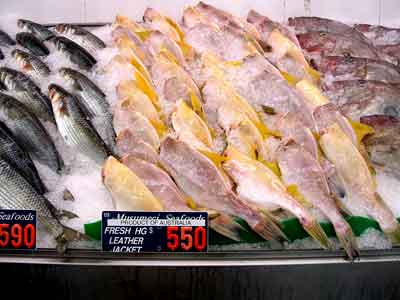
Chillis are members of the capiscum family of all shapes, sizes and colours which grow in tropical and sub-tropical countries. They are green or red, often tapered and contain twice as much capsaicin as red peppers, which is why they provide so much heat to food. They are often available in dried or powdered forms. Colour is not necessarily a guide to the heat, which is measured in Scoville units (named after Wilbur Scoville). Generally speaking the scale goes from small and pointed, with thin skins, having the most heat through to large and blunt having the least. The greatest heat is contained in the membranes and seeds, which are attached to the "placenta" of the chilli. Certain chillis are almost only available dried while others are traditionally used in their fresh form. Aromatic chillis are often eaten raw in salads and salsas in Latin America.
Chilli bean paste is one of a variety of salty seasonings made from fermented soya beans, either yellow or black, salted and dried or mixed with brine, used in cooking and as a condiment.
Various highly flavoured bottled sauces available commercially. They are made from crushed red or green chillis with tomatoes, onions, sugar, spices and vinegar.

A name for the ocean jacket. This fish is usually marketed headless as the head is held to be very ugly. They are found in the southern coastal waters of Australia. The head is practically half the length of the fish with a very small mouth with beak-like teeth. The smooth skin which, like the monkfish (US: angler fish), does not have normal scales, is always removed for cooking. You can see that these are likely to be deep water fish. The firm flesh has a distinctive flavour and they are a useful addition to soups.

A name for the ocean jacket. This fish is usually marketed headless as the head is held to be very ugly. They are found in the southern coastal waters of Australia. The head is practically half the length of the fish with a very small mouth with beak-like teeth. The smooth skin which, like the monkfish (US: angler fish), does not have normal scales, is always removed for cooking. You can see that these are likely to be deep water fish. The firm flesh has a distinctive flavour and they are a useful addition to soups.
Atlantic rock oyster. A variety of oyster up to 15 cm (6") in length found on the American side of the Atlantic. Unlike many oysters this is usually cooked, served on the half shell. This is because it is quite a fatty oyster, particularly when large, which is improved by cooking. All down the eastern seaboard the Atlantic oyster is called after the area in which it is found, e.g. the Long Island oyster, Chesapeake Bay oysters and so on. The best known is probably the bluepoint.